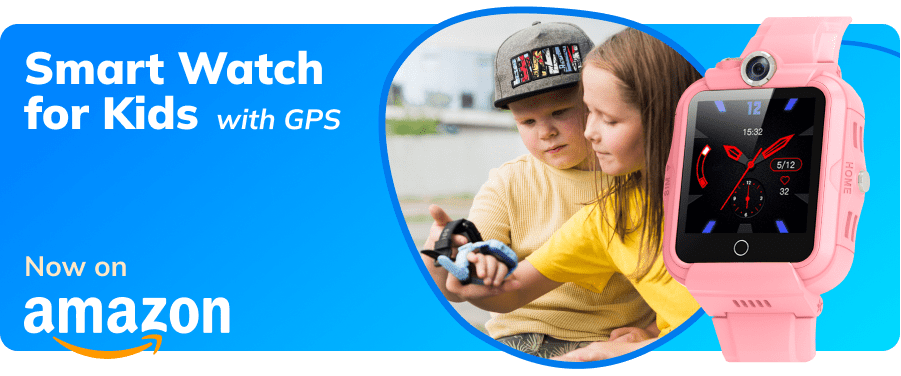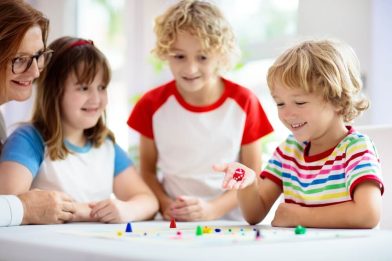Best Music Games for Kids of All Ages

Music games are great for kids. As well as being lots of fun, they also enhance cognitive abilities, improve hand dexterity, develop fine motor skills, help children learn basic skills, improve literacy skills, boost social skills, and more. We’ve rounded up the very best musical games below, including DIY activities and where you can find great music games—for free—online. Let’s dive in!
Contents:
- Fun and Educational Music Games for Kids
- DIY Music Activities to Try at Home
- Tips for Choosing the Right Music Games
- Why Music Games Are So Beneficial for Kids
Fun and Educational Music Games for Kids
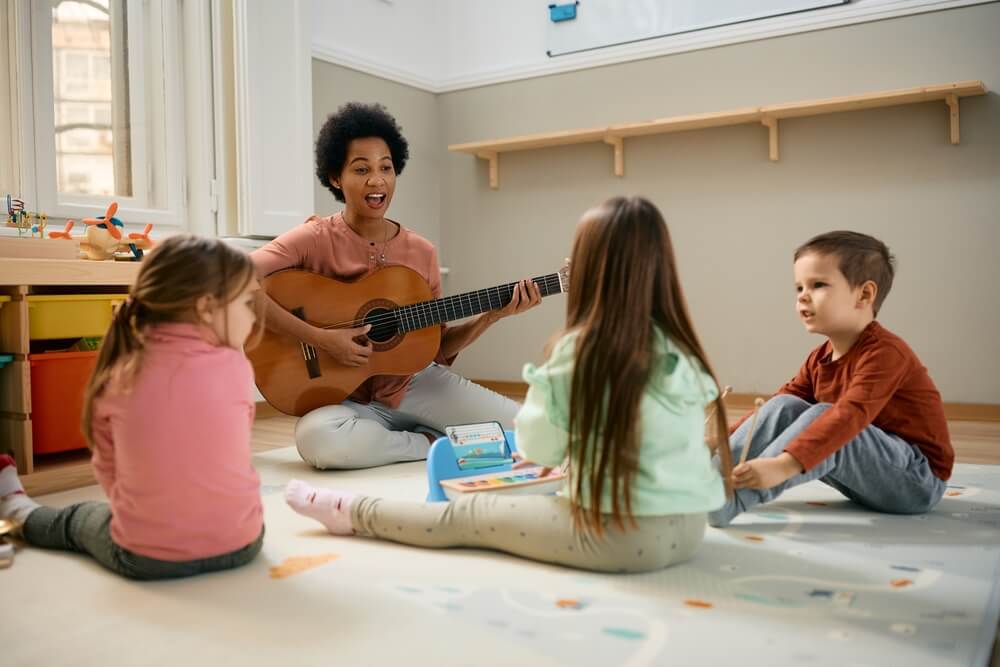
Drazen Zigic/Shutterstock
Looking for engaging ways to introduce your child to music without overwhelming them? Music games for kids offer just the right mix of fun and learning. They’re perfect for encouraging creativity, improving coordination, and helping kids explore rhythm in ways that feel natural and exciting. Whether you’re a parent at home or a preschool teacher looking for fresh ideas, there’s something for every age and energy level.
Preschool Music Games (Ages 3–5)
At this stage, kids are naturally drawn to rhythm and sound—and music games can support everything from motor skills to social-emotional learning. The key is to keep things simple, interactive, and full of movement. Here are a few tried-and-true activities that preschoolers absolutely love.
Finding the Beat with Body Percussion
With this simple and fun music game, children use different parts of their bodies as instruments. They’ll be amazed at just how many different sounds they can make with their body, such as patting, clicking, and clapping! Once kids have got the hang of it, put on some music and suggest they try to follow along with the beat or melody using their new sounds.
Make a Musical Marching Band
Fun music games don’t get much simpler than a marching band activity! The beauty of this game is that you can use all kinds of everyday household objects for instruments, such as wooden spoons, containers filled with rice, empty coffee canisters, etc. And if you have any instruments like maracas or tambourines around, get them into the mix, too.
Put on some music with a simple, strong beat and ask the kids to play along with the tune—and then get ready to march around the room (or the whole house) as a happy band!
Get Your Animal Grooves On!
Kids will have lots of laughs with the animal dancing game—plus, it’s great for helping little ones learn to socialize. Play some lively music for kids to dance to. Once they’re enjoying themselves, call out the name of an animal. Now the children need to dance like these animals, whether it’s swaying their ‘trunks’ like an elephant or pecking their ‘beaks’ like a bird! If noise levels aren’t an issue, you could ask the kids to make the sounds their animal would make as they’re boogying.
Have a Go at Musical Painting
Looking for a calming musical activity to get the morning off to a great start? Try musical painting. Simply set your preschooler up with some painting materials (or crayons), put on some music, and ask them to paint as they listen to the songs. You may like to try putting on different styles of music on different days (or even times) to see how the children’s creations change in tone.
Alternatively, put on a longer melody, such as some classical music from a composer like Mozart or Schubert, and ask kids to paint a representation of the music as they visualize it in their mind’s eye.
Get Ready to Limbo
Limbo is a super musical activity that burns energy and gets the heart pounding. Kids will enjoy this silly game as they try to dance beneath the limbo ‘pole.’ All you need is some form of stick for kids to try to limbo under (a broom or even a dressing gown belt will do) and some favorite, fun tunes to accompany the action.
As well as being an energetic way to keep kids occupied, limbo is also great for developing gross motor skills, coordination, and balance, and strengthening leg muscles.
Sound Bingo
This musical take on a classic game is a fantastic rainy day activity or makes for a brilliant party game. Start by preparing bingo cards with instrument names, musical notes, or musical symbols instead of numbers, making sure that each card has a different sequence of these symbols. Give each child one of these cards. Now, call out the various instruments, notes, or symbols—the first child to complete a straight line (or the entire bingo card if you want a longer game) shouts out ‘Bingo!’ and is the winner.
The Wheels on the Bus
A long-time classic musical game enjoyed by generations of preschool kids, The Wheels on the Bus will get kids moving and laughing! Play the kids the song and show them the actions that go alongside each section, such as moving the hands and arms around in a circle for the wheels on the bus going around, and stretching up and squatting down for the people on the bus going up and down. Children will love to sing along and join in with the movements.
Check out this video for a helpful, easy piano play-along to get started.
Freeze Dance
Kids are sure to be delighted with this fun game; it’s perfect for the classroom, a party, or when you simply need a quick activity to keep children occupied for ten minutes. Play some music and invite the children to have a good dance and show off their best moves! When you pause the music, kids must freeze and hold the pose until the music starts again. If they wobble, they’re out!
Freeze Dance is good for learning to listen actively and promotes gross motor skills.
If You’re Happy and You Know It
Most of us remember the If You’re Happy and You Know It song and actions from our childhood, so why not teach this simple, happy activity to your own kids? As well as helping with physical coordination, it enhances memory recall, and nurtures social engagement and emotional expression. Try using this vibrant video to sing along to, and get kids familiar with the actions.
What Can You Hear?
Help develop verbal expression and active listening skills with this game, which is perfect if you haven’t got much space. Play a song and ask the children to describe what they can hear. This could be about the instruments they hear, for example, the mood the music evokes, or any memories that may be associated with the tune.
Encourage kids to think about the tempo of the music, its dynamics, and what it makes them think of. Is it happy or sad, lively or slow-paced? What sort of cartoon or movie could it accompany? What do the children like or dislike about it?
Elementary School Music Games (Ages 6–10)
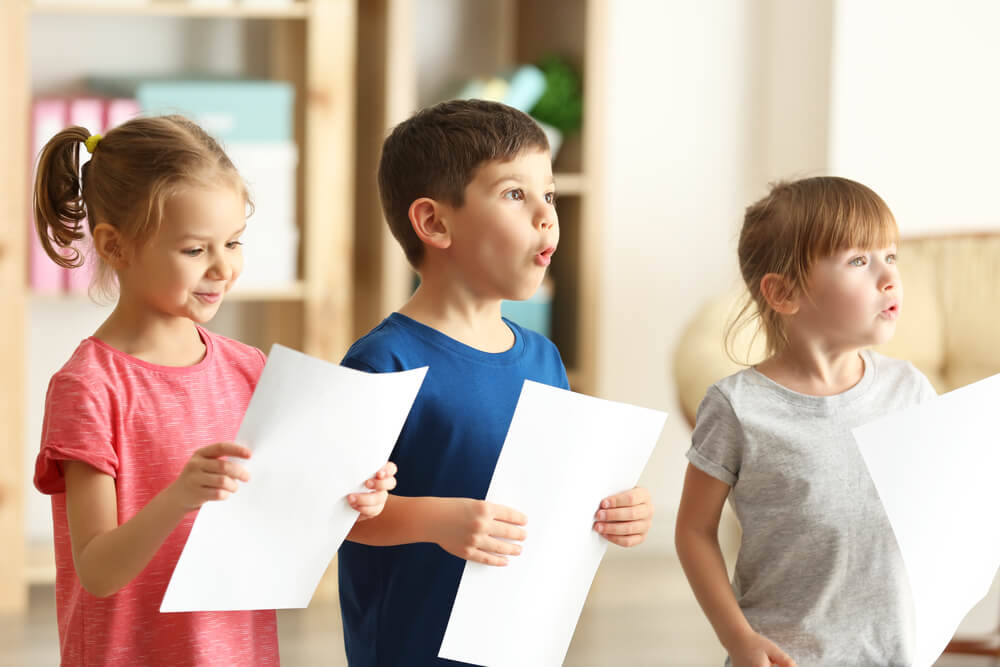
Africa Studio/Shutterstock
As kids get older, they’re ready for more structure in their play—but that doesn’t mean it has to be less fun. Music games for kids in this age group can be a great way to support focus, teamwork, and early music literacy. These games introduce more rules and even light competition while still giving plenty of space for creativity and movement.
Here are a few favorite options that blend music with strategy, social skills, and a whole lot of fun.
Drum Tag
All you need for this game is a drum and some open space! The aim of the game is to be the last person to be tagged. The drummer plays a beat or pattern of beats, and each player must take one step for every beat as they try to tag others—and not get tagged themselves! Any player who is tagged must sit out—and both sit out if two players tag each other at the same time. Any player who takes extra steps is also out. The last person to be tagged is the winner and is the drummer for the next match.
Little Maestros
Elementary school kids will love this game, which is a wonderful way to introduce writing and reading sheet music. Start by creating some simple symbols to designate different sounds that kids can make with their bodies. For example, a square could mean a handclap and a circle a foot stamp. It’s a good idea to make at least four symbols. Now, give kids pens and a sheet of paper and show them how to compose a rhythm based on the symbols you’ve made. Once children have each created a composition, have a go at performing it as a group.
Musical Hot Potato
For this game, you’ll need a whiteboard or a large sheet of paper on which you write down five questions, such as ‘What is your favorite song?’, ‘What food do you like best?’ or ‘Where would you most like to visit in the world…or the universe!?’ Now, ask children to sit in a circle, put on some music, and get kids to pass a ball (or other small item) around the circle—when the music stops, the child holding the ball has to answer one of the questions.
Have a Go Composing a Rap
This activity is a great way of getting kids engaged with musical composition, especially as it doesn’t require children to be able to read or write sheet music. Start by getting kids familiar with rhymes and their underlying patterns, such as AABB and ABBA. Now, put children into small groups and ask them to come up with a short rap, perhaps suggesting some topics to get them started, such as summer vacation, the environment, or their pets. Once the raps have been written, each group can perform their compositions.
Poison Rhythm
Start by clapping out a four-beat rhythm, which will now be known as the ‘poison rhythm.’ Next, clap out a series of four beat rhythms and have the kids repeat them back to you—however, if you clap out the ‘poison rhythm’, they should remain silent! Anyone who does begin to clap this rhythm is out of the game!
Name the Tune
This musical game is perfect for groups of children. Have kids split into several teams and, to add to the fun, ask them to choose a team name. Give each team a pen and sheet of paper. Play a couple of seconds of a song (it could be a pop favorite or a much-loved oldie) and have each team write down the name of the song and the artist or band. Play a set amount of song extracts and then add up the scores to find the winner—teams get one point for each song correctly identified and one for each singer or band they get right.
Create a Random Rhythm
Make getting started with music notation fun with this entertaining activity. Begin by giving each child a six-sided die and assign a musical value to each number. For example, number one could be a crochet, while number four is a semibreve and number six a musical rest. Each student rolls their dice and adds the relevant musical symbol onto a blank page. Once sixteen bars of rhythm have been completed, have each child clap it aloud.
What’s That Instrument?
Introduce kids to an array of instruments with the What’s That Instrument? game. Gather children together and play short audio clips of various instruments being played, and see if kids can correctly guess what they are. Make things more interesting by incorporating some unusual instruments, like the harpsichord or bagpipes!
Rhythm Relay Race
Separate kids into teams and set up several musical ‘stations,’ each of which has a different percussion instrument. Each team member needs to run to a station and use the instrument there to play a rhythmic pattern before passing the instrument to the next member of their team to repeat the pattern. The winner is the team that finishes the relay race with the most cohesive and accurate rhythms.
Interactive Online Music Games and Apps
Looking for online music games for free? There are plenty out there—take a look at some of the apps and platforms we’ve listed below.
Chrome Music Lab

Credit: musiclab.chromeexperiments.com
Recommended age: 5+
Chrome Music Lab is a free platform on a mission to get kids engaged with music through a range of hands-on, fun activities. The Song Maker experiment allows kids to easily compose their own music with just a few clicks of the mouse. Tap onto different squares to generate sounds, and try out different tempos, tones, settings, and much more. It’s like having a complete orchestra at your fingertips!
Sesame Street Makes Music
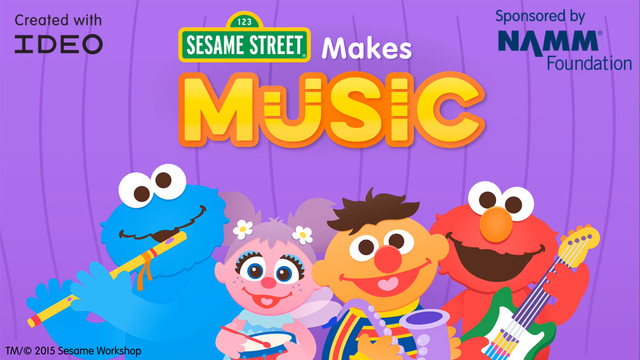
Credit: Sesame Street Makes Music
Recommended age: 3+
The classic childhood favorite Sesame Street gets musical with this app, with stars like Ernie, Abbie, Elmo, and the Cookie Monster on hand to get kids singing and moving along to songs like ‘The Wheels on the Bus’ in a range of musical styles. Children can also experiment with ten user-controlled instruments and interact with the show’s characters while playing with rhythms and tempo.
Lagged Music Games
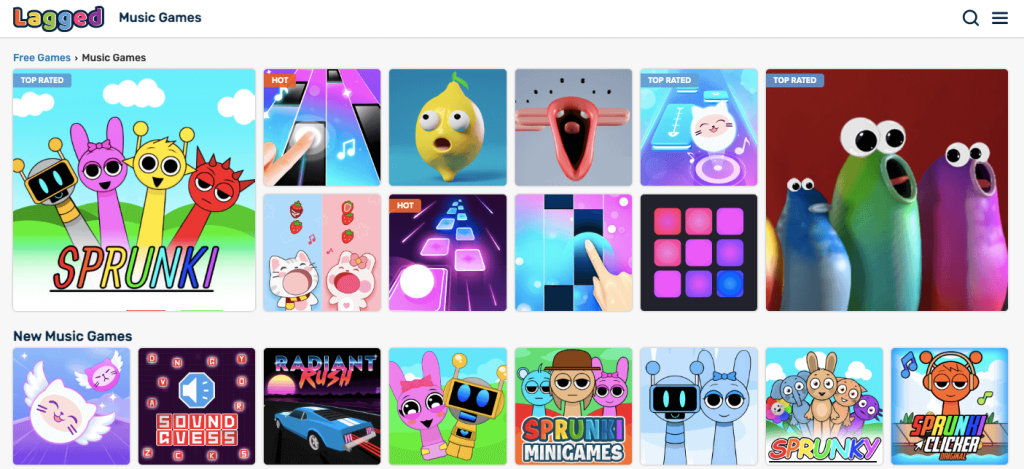
Credit: lagged.com/en/music
Recommended age: 5+
Offering a huge library of free music games on the web, Lagged can be accessed via any browser or device. Some of the top games on offer include Piano Online, Tiles Hop, Blob Opera, Magic Tiles, and Choir. Players can earn rewards and points and even enjoy competing against each other.
Kidloland Kids and Toddler Games
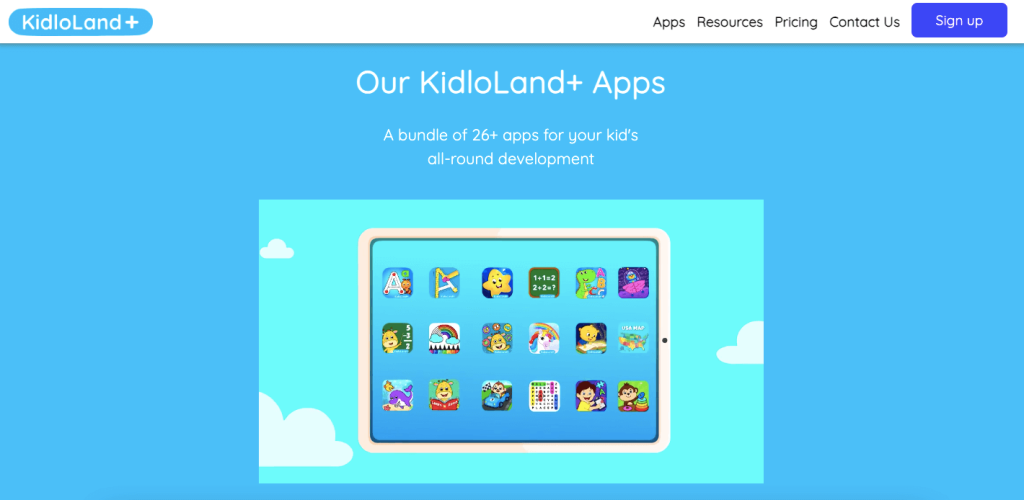
Credit: kidloland.com/apps
Recommended age: Under 5s
This app boasts hundreds of kids and toddlers’ learning games, nursery rhymes, and baby songs and is perfect to introduce preschoolers to musical activities. Young children will love to interact with the characters onscreen as they play or sing along—and once downloaded, the songs and nursery rhymes can be enjoyed offline, too.
Mussila Music School

Credit: mussila.com
Recommended age: 5+
This app features more than 1,000 musical challenges and 20 music courses, and is a fantastic way to help kids learn about music and develop their musical vocabulary. Children will learn about famous composers like Bach, Chopin, and Mozart, while the DJ feature allows budding artists to mix their own music.
Let your kids explore musical games with peace of mind! Use Findmykids to ensure your child’s screen time is safe and balanced while they enjoy interactive music games. Keep your family connected and secure.
DIY Music Activities to Try at Home
Not every great music game needs a screen, a classroom, or even traditional instruments. Sometimes, the best music games for kids are the ones you create together at home—with whatever you have on hand. These DIY activities are not only budget-friendly, but also encourage creativity, problem-solving, and hands-on exploration. Plus, they’re just plain fun to do as a family!
Whether it’s a rainy afternoon indoors or a spontaneous after-school project, these simple music-making ideas offer kids the chance to learn through building, listening, and experimenting with sound in everyday life.
Make an Easy Guitar
Enjoy a fun hour with your child by making a simple guitar and then experimenting with the sounds you can make with it. All you need is a shoebox without the lid (or a similar shaped and sized cardboard box) and a handful of elastic bands.
Wrap four to six rubber bands around the box, leaving space between each band. If children are feeling creative, they could paint or decorate their guitar base before this step. Now encourage your child to experiment with the different types of sound they can make on their ‘guitar’—can they create a simple melody?
The Sounds of Daily Life
No equipment at all is required for this musical activity, which can be enjoyed anywhere, whether from the quiet comfort of the sofa or during a walk to the store. Before you set out, whether to the park on foot or by car to school, talk about the different noises and sounds you might hear on the journey. Are you likely to hear birdsong, for example, music, the noise of traffic or people talking, the sound of the wind in the trees? Afterwards, chat together about the noises you heard—were there any surprises? A lovely idea is to ask your little one to draw the journey and then play it using household objects or their bodies to make percussive and other sounds.
Make Music with a Rainmaker
A DIY rainmaker is just as much fun to make as it is to play! All you need is a long cardboard tube (such as that used for tinfoil), some paint, glue, glitter or sequins, and some uncooked lentils or rice.
Ask the kids to first paint their tube and allow it to fully dry. Once this is done, suggest they decorate it with sequins, glitter, or whatever other craft materials you have to hand. Now, it’s time to cut out a couple of cardboard circles and glue the first securely to one end of the tube.
Fill the tube about one-fifth full of rice or lentils, and then securely glue on the second cardboard circle to seal everything inside. And now the rainmaker is ready to go!
Play some music and suggest your child tries to shake the tube along to the beat, or experiment with the difference in sounds that can be made by, for example, turning the rainmaker either quickly or slowly, or up and down and from side to side.
Tips for Choosing the Right Music Games
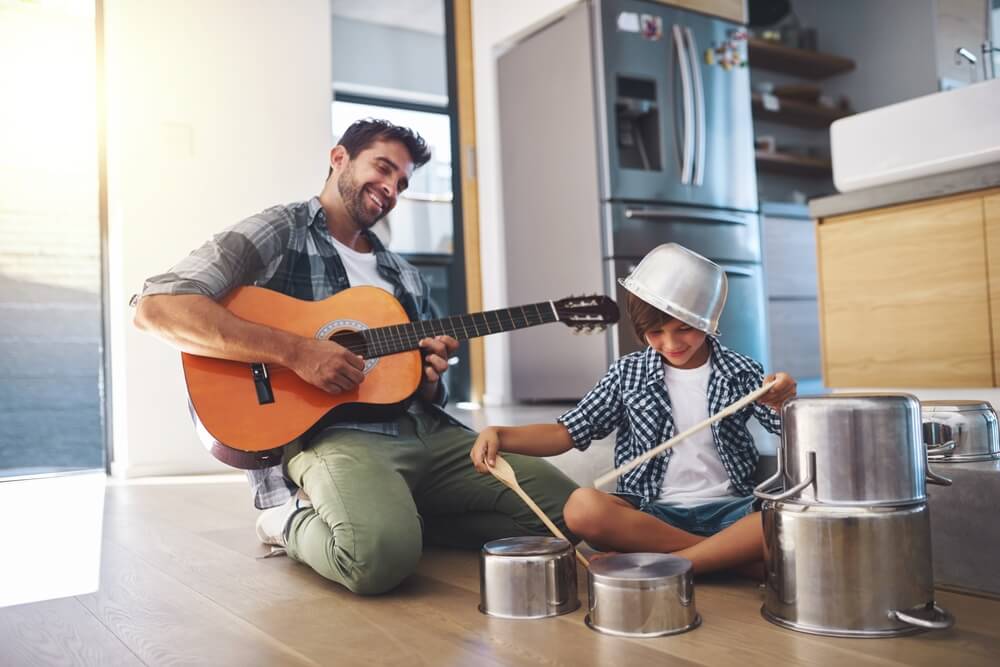
PeopleImages.com – Yuri A/Shutterstock
There are so many wonderful music games for kids that it can feel a little tricky to choose the best one for your child. Don’t worry, we can help! Here are the key things to take into account.
Age Appropriateness
Firstly, it’s important to ensure the musical game or activity is age-appropriate for your child. This will avoid frustration and help ensure your kid enjoys the best experience possible. The games we’ve detailed above are categorized into those suitable for pre-school and elementary school age children to help you identify the most suitable for your little one.
Balancing Fun and Educational Value
It’s a good idea for the musical game you choose to have some solid educational value, but if it’s no fun, you’re going to have a hard time persuading children to give it a go. The best games combine both seamlessly, meaning that kids don’t even realize they’re learning. An example is Little Maestros, which is highly entertaining while also teaching kids the fundamentals of musical notation.
Encouraging Participation
Some kids, especially those who are shy or sensory-sensitive, may find it particularly difficult to participate in music games, especially with their element of performance. To help, ensure that each activity or game is clearly explained and that all children understand the rules or what’s expected of them.
For group games, putting kids in small groups of two or three is also useful. Patience is vital, too: some children may take a little longer to work up to speaking or taking part, and showing empathy and understanding is absolutely key to helping them feel comfortable and more confident.
Why Music Games Are So Beneficial for Kids
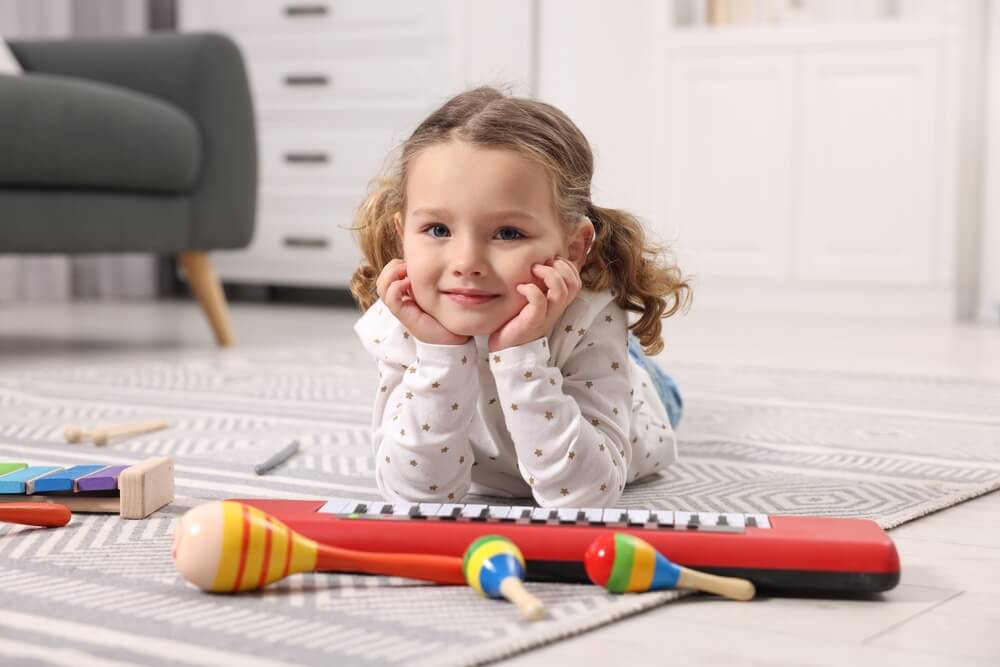
New Africa/Shutterstock
Music games are good for kids’ development in so many ways. These include:
- Development of active listening skills and auditory processing skills
- Nurturing of fine motor skills
- Enhancement of cognitive abilities
- Improvement of hand and finger dexterity and strength
- They are great for self-expression and building self-confidence
- Development of communication and literacy skills
- Group games and activities help with social skills
- Great for promoting physical activity
- They can be used for relaxation
Musical Games to Nurture a Lifetime Love of Music and Boost Skills
It’s never too early to start enjoying music and musical games with your child: even babies love being sung or hummed to. Music games offer a wealth of benefits and can support your child’s development in multiple ways, from boosting hand-eye coordination to developing self-confidence and building literacy skills. Not to mention, they help instill a lifelong love of music.
Try introducing some of the music games and activities we’ve listed above into your child’s daily schedule, whether that’s at playtime, on the walk to the park, or as part of your nightly wind-down routine. As well as fostering creativity, a sense of rhythm, and confidence, they’re also a wonderful chance to bond. So get set to enjoy plenty of singing, clapping, marching, and dancing together, all through the day!
Cover image: Pixel-Shot/Shutterstock
Проверьте электронный ящик

